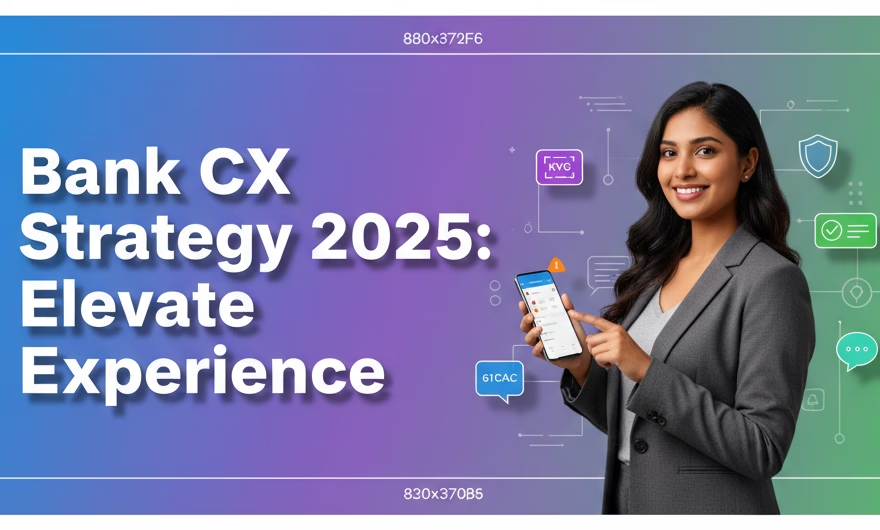Investing in and improving customer experience is possibly the best CX strategy for banking institutions. In 2025, as customers compare banks with their best digital experiences elsewhere, making customer experience the sole differentiator of your brand can have a major positive impact on growth, loyalty, and cost-to-serve. Below is a practical, four-step approach to improving customer experience in banks while staying compliant and secure.
1. Plan
Have a set of defined goals and targets, identify your audience, and create campaigns targeting specific audiences with different strategies for each demographic. Strengthen your plan with the following:
- Define a CX North Star: Set clear outcomes (for example, higher activation rates, lower first-contact resolution time, improved NPS/CSAT) and link them to business KPIs like cost-to-serve, cross-sell, and churn reduction.
- Segment with purpose: Go beyond demographics to behavior, value, and life stage segments. Identify high-priority journeys (onboarding, payments, servicing, collections) for each segment.
- Map journeys end-to-end: Capture current-state steps, emotions, channels, and pain points. Include branch, contact center, app, web, and messaging channels to ensure true omnichannel continuity.
- Establish data foundations: Audit first-party data quality, consent, and accessibility. Define how profile, transaction, and interaction data will be unified for personalization and measurement.
- Align on compliance and risk: Build CX plans that meet regulatory expectations on KYC, fair lending, data privacy, and grievance redressal. Document operational resilience for critical journeys (for example, payments and authentication).
- Set a realistic roadmap: Prioritize quick wins (e.g., reducing IVR friction or simplifying FAQs) while planning for structural fixes (e.g., systems integration, identity verification enhancements).
2. Strategize
Create a customer experience strategy to achieve your goals and targets. Your strategy should balance convenience with trust, automation with empathy, and short-term wins with long-term capability building.
- Design for omnichannel continuity: Make it easy to start in one channel and continue in another without repetition. Ensure contact center, branch, and digital teams share context and follow the same playbooks.
- Personalize responsibly: Use first-party data to tailor offers, advice, and service prompts. Personalization should be transparent, consented, and clearly beneficial to the customer.
- Build security and compliance into the journey: Use strong yet low-friction authentication (for example, device binding, OTP with risk checks, or voice biometrics where appropriate). Keep fraud controls invisible where possible, surfacing only when needed.
- Leverage Video KYC (V-CIP): RBI has approved a video-based customer identification process under its KYC framework. As of 2025, V-CIP continues to streamline compliant remote onboarding when implemented by eligible regulated entities, helping you reduce drop-offs and branch dependency.
- Empower employees: Equip frontline and back-office teams with unified customer context, clear next-best-actions, and knowledge bases. Great employee experience fuels great customer experience.
- Prepare service recovery playbooks: Define how to detect issues early (e.g., failed transaction alerts), proactively reach out, and close the loop with customers to restore trust.
- Adopt AI with human oversight: Use AI to triage intents, suggest responses, and predict churn or next-best-offers, keeping humans in the loop for high-stakes interactions. Monitor for accuracy, bias, and explainability.
- Articulate the business case: Quantify expected impact on acquisition, activation, usage, and cost-to-serve. Tie investments to measurable outcomes and establish a governance cadence to stay on track.
3. Improve CX
Take action and implement proactive measures to design experiences for each of your customer segments. Focus on the moments that matter most across onboarding, everyday banking, support, and collections.
- Onboarding and activation:
- Simplify account opening with digital forms, auto-fill from verified sources, and contextual help. Use nudges to complete pending steps.
- Adopt Video KYC to securely verify identity without branch visits. It can save time, reduce paperwork, and improve conversion while maintaining compliance.
- Offer instant virtual cards or limited-feature accounts that seamlessly upgrade post-verification to accelerate first use.
- Servicing and support:
- Enable intelligent self-service through IVR, chat, and messaging apps like WhatsApp for common tasks like balance checks, card controls, and dispute updates.
- Use smart routing in the contact center to connect customers to the right agent with full context, minimizing transfers and hold times.
- Send proactive notifications for bill reminders, suspicious activity, failed transactions, or approaching limits with clear next steps.
- Balance automation with empathy: escalate seamlessly to human agents for complex or sensitive cases such as fraud, hardship, or collections.
- Payments and everyday banking:
- Design flows that are quick, transparent, and reversible where policy permits. Show fees upfront and provide confirmation and receipts in the customer’s preferred channel.
- Offer card controls, spending insights, and alerts that help customers stay in control without needing to contact support.
- Trust, security, and privacy:
- Reduce friction with risk-based authentication. Add step-ups only when risk signals warrant it.
- Provide clear privacy controls and plain-language explanations of data use to build confidence.
- Relationship growth:
- Use next-best-action models to surface relevant offers, financial wellness tips, or reminders that align with customer goals.
- Create life-event playbooks (salary credit, new city, new family member) to proactively deliver timely value.
- Accessibility and inclusion:
- Support regional languages, low-bandwidth experiences, and accessible UI patterns for customers with disabilities.
- Offer choice of channels—branch, phone, app, and messaging—without penalizing customers for their preferences.
4. Measure and Refine
Collect data and use a data-driven strategy to take business decisions. Move from anecdotal feedback to a closed-loop system that continuously improves journeys.
- Track outcome metrics: Monitor CSAT, NPS, Customer Effort Score, first-contact resolution, average handle time, abandonment, digital adoption, and complaint ratios. Align these with financial metrics like acquisition cost, cross-sell rate, and churn.
- Instrument key journeys: Measure funnel drop-offs for onboarding, payments, and dispute resolution. Identify the exact steps where customers abandon and fix root causes.
- Voice of the customer: Collect feedback through in-app surveys, post-call surveys, and complaint analysis. Tag feedback to journey stages to prioritize action.
- Quality and compliance monitoring: Use conversation analytics and quality scorecards to ensure agents follow policies and provide accurate information.
- A/B test improvements: Validate new flows, scripts, or offers on small cohorts before scaling. Track both experience and operational impacts.
- Review and iterate regularly: Establish a governance rhythm to review insights, decide on fixes, and communicate progress. Share wins and learnings across teams to sustain momentum.
- Safeguard data and models: Monitor data quality, consent compliance, and AI model performance. Ensure changes remain aligned with regulatory expectations.
Conclusion
If you’re a retail bank or financial institution concerned about the quality of customer experience in your business, FusionCX is your answer to an improved banking experience. Having a well-equipped contact center is very important to achieve success in the banking sector. Check out Ameyo by Exotel’s contact center for banking and how it helped improve end-to-end customer journeys—from onboarding to servicing to collections. If you’re more interested in debt collection and recovery, we have a great guide on how you can increase debt collection by 200%.
To improve the banking experience, RBI has approved a video-based identification process for KYC. As of 2025, Video KYC (V-CIP) continues to simplify onboarding and authentication when implemented by eligible regulated entities. Video KYC saves time, improves digital security for documents and other data, and enhances customer experience by allowing customers to verify their identity by showing their documents on camera—reducing branch visits and accelerating account activation.
By planning deliberately, strategizing for omnichannel and trust, implementing high-impact improvements, and measuring what matters, banks can turn CX into a durable competitive advantage.
Start with the journeys your customers care about most, empower your teams with the right tools, and iterate continuously to deliver banking experiences that are simple, secure, and satisfying.




